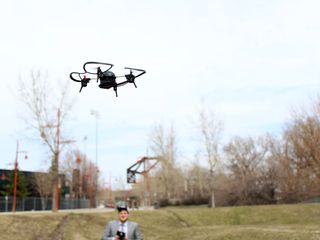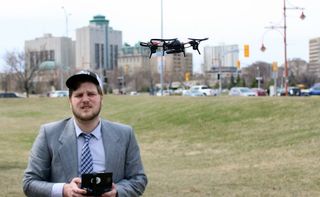How to clean and take care of your drone

If you've just bought your first drone or are considering picking up the hobby, you'll want to get into a good habit of properly caring for your drone and its parts. It's important to keep your drone clean of dust and grime to ensure it's ready to fly the next time you grab it and head out the door.
Every drone is slightly different and will have its own specific upkeep requirements to make sure everything is good to go, but we'll break down some general tips, as well as some tools and products you should have on-hand to ensure you're keeping your drone in tip-top shape.
What you should use to clean your drone
Building yourself a small toolkit filled with everything you'll need to care for, clean, and repair your drone while in the field is a great practice to start from the get-go. Again, the specifics of some of these things are going to be dependent on the make and style of drone you're flying, so use the following list as a jumping-off point for creating your own drone kit. We've also included links to Amazon for everything mentioned below:
- A small, soft cleaning brush: Good for wiping away dust or debris that might get into tight corners or crevices on your drone. Alternatively, you can use pipe-cleaners.
- Canned air: Another great tool for clearing out dust and dirt from tough-to-reach spots on your drone such as around the motors or near the circuit boards. It also won't damage the electronics at all.
- Isopropyl alcohol: Great for cleaning your drones shell. Should work well for cleaning off dirt, grass stains, blood, bug guts — pretty much everything. Make sure you get the 99% stuff so you don't damage your circuits.
- Microfiber cloth: Another tool for wiping down and cleaning out dust and dirt. Helpful if you're able (and willing) to disassemble the quadcopter motor for a full-on clean. Works well with the isopropyl alcohol.
- 3-in-1 lubricant: Check with your drone's manufacturer, but if your drone's motors require lubrication, you'll definitely want a bottle on you at all times when flying.
What you should have to repair your drone
When you're out in an open field flying your drone, the last thing you want is to ground your drone because you weren't prepared. Crashes happen, parts come loose, and props fall off. Here are the essentials you should have in your kit when you're out flying:
- Extra props: A no-brainer. Props are typically the first thing to fly off or get damaged if you crash; they're also one of the most essential parts keeping your drone in the air. Keeping an extra set of props (or two) on you at all times means that, if you damage or lose a prop in the field, you can just pop new ones on and get back to it. If you're forced to replace a prop or two, you're best off replacing the whole set, and always make sure you're buying the right size props to fit your drone. Your best bet is to check with the drone's manufacturer to confirm which props fit.
- Small toolkit that's right for your drone: What we mean to say is, make sure you've got the tools needed for quick field repairs. Your drone might be designed so that you don't need any tools at all or it may have come with all the tools you need. Depending on your situation, you might only need a small screwdriver to ensure everything is tight and secure.
- Soldering iron: You probably won't be taking the soldering iron out in the field with you, but if you end up causing some significant damage to your drone's wiring or electronics, a soldering iron will definitely come in handy. This is also the point that separates the hobbyists from the casuals. If you've never used a soldering iron in your life, ask a friend who has for help or venture onto YouTube for some DIY help.
- Extra batteries: Again, this one is very specific to the drone you own. If your drone has replaceable batteries, you'll definitely want to have fully-charged spares for when your battery eventually dies or for worst-case scenarios where your battery gets damaged.
General tips

Do a proper pre-flight check
Before you start flying your drone, you should go through a basic pre-flight checklist. There might be some specific steps to check for, depending on the make and model of your drone or if you're flying FPV, but here are some general things you should be certain of before taking off.
- Are you in a clear and open space where it's safe to fly? Eliminate your chances of getting into trouble by flying away from trees, buildings, cars, people, and animals.
- Is your drone in good working condition? Check the props for damage and make sure they're able to spin freely.
- Check the toggle switches on your controller. Make sure you've got things set up the way you want, so there's no surprises once you get into the air.
- If you're in the U.S. you'll need to register any drone weighing over .55 pounds with the FAA.
Always fly with a fully-charged battery
Be an expert in 5 minutes
Get the latest news from Android Central, your trusted companion in the world of Android
Pretty much all quality drones come with a rechargeable lithium-ion or lithium-polymer battery, and you'll want to make sure you're taking extra good care of your batteries as you are the rest of your drone. That means flying with fully-charged batteries and removing them (if possible) when you're done flying.
Remove and clean props after every flight
As a novice drone pilot learning the ropes, you're likely going to be crashing early and often. A quality drone is built to withstand some wear and tear, but dirt and grime build up in your motors will force them to work harder and might result in locking up midair.
Therefore, best practice is to remove your props and give the motors a good spray of canned air to clean out any dust or debris that might have gotten into the motor housing. If you let that dirt and grime build up it will only require a more thorough cleaning later, so take the time after every flight to clean things out.
Give those motors a break
We know, once you start flying your drone, you just don't want to stop. You'll head out into the field with a couple fully-charged batteries to keep your drone in the air for marathon sessions.
Your motors need a break every now and again or else you risk them overheating and wearing out. This will largely depend on the size and quality of your drone, but if you've spent a whole afternoon flying, make sure to give those motors a rest before heading out for a twilight flight.
Got any tips?
Are you an experienced drone pilot? Share you tips for drone care in the comments below.
Marc Lagace was an Apps and Games Editor at Android Central between 2016 and 2020. You can reach out to him on Twitter [@spacelagace.

